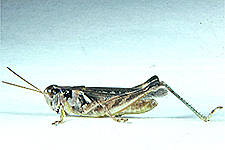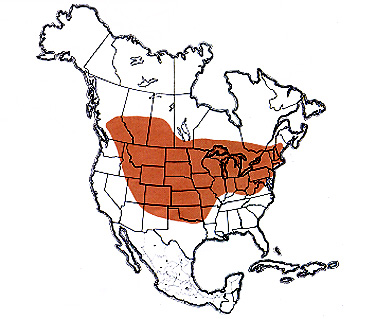Grasshoppers of Wyoming and the West
Entomology
Pasture Grasshopper
Melanoplus confusus Scudder
 |
Distribution and Habitat
 M. confusus continental distribution map >
M. confusus continental distribution map > The pasture grasshopper, Melanoplus confusus Scudder, ranges from the northeastern states to the western states and provinces. It inhabits the grass prairies of the West and the meadows and pastures of the Midwest and East.
Economic Importance
This species is commonly present at low densities in grassland habitats. It occurs early in the season when vegetation is green and abundant, causing little or no economic damage. There have been small outbreaks, however, in association with the clubhorned grasshopper in Saskatchewan that have caused damage to pastures and grain fields.
Food Habits
The pasture grasshopper is a mixed feeder consuming both grasses and forbs. Based on examination of specimens collected from several different states, grasses in crop contents have ranged from 22 to 49 percent and forbs from 45 to 100 percent. Thus, this grasshopper feeds more on forbs than grasses. Preferred species of forbs include western ragweed, spreading wildbuckwheat, cudweed sagewort, and western sticktight. Preferred grasses include early-season species, e.g., downy brome, Japanese brome, and Kentucky bluegrass. In addition, substantial amounts of other materials such as pollen, fungi, and arthropod parts have been found in crops. In Michigan a species of goldenrod is a favored host plant.
Migratory Habits
The pasture grasshopper is a strong flier with wings extending to or beyond the end of the abdomen. In the Rocky Mountains of Colorado it is a resident up to 9,000 feet and an "accidental" between 9,000 and 11,000 feet. It also appears as an "accidental" at montane elevations within its resident range before adults have matured at such elevations. Evidence of a mass emigration from a drought-stricken area of the mixedgrass prairie of Wyoming was observed in 1989. A heavy infestation of three species of grasshoppers had developed around an overflowing water tank and retaining pond in use the previous several years but shut off in 1989 because of absence of cattle in the pasture. On July 1 the three species - the clearwinged, migratory, and pasture grasshoppers - were present as adults even though the vegetation had started to dry because of drought and was nearly depleted due to the feeding of the grasshoppers. On visiting the area on July 20 few grasshoppers remained. Most had evidently emigrated from the site. Apparently all three species have the capacity to move when food becomes scarce. At that time they fly to more favorable habitats.
Identification
Adults of the pasture grasshopper (Figs. 6 and 7)are medium-sized and drab gray and brown. The underside of body is cream colored. A patch behind the compound eye on the side of the head and the pronotal lobe is usually solid black and shiny. The shape of the male cercus, twisted and bent medially, is diagnostic (Fig. 8). Wings are long. Underside of hind femur is orange, occasionally yellow. Hind tibia is greenish blue.
The nymphs (Figs. 1-5) are identifiable by their shape, stripes, and color:
1. Head with face nearly vertical; face colored tan or green and spotted; antennae filiform; compound eye with broad dark stripe running diagonally in center and a narrow light line on each side of this stripe. (This character is diagnostic. See Figure 5 for clear illustration).
2. Cream-colored crescent begins on side of head below compound eye and runs onto lobe of pronotum; however, side of head may be solid brown or green without crescent in instars III, IV, and V and a cream-colored line present only on pronotal lobe.
3. Medial area of hind femur variable - with fuscous stripe entire, with fuscous stripe cut, or with solid color and no fuscous stripe.
4. Body color is green or drab gray-brown; underside greenish.
Hatching
The pasture grasshopper is a very early hatching species. The first instar nymphs appear in early spring two to three weeks ahead of nymphs of Aulocara elliotti and Melanoplus occidentalis. First instars can be collected along with adults and late instar nymphs of overwintering species such as Eritettix simplex and Psoloessa delicatula. Hatching continues for a month.
Nymphal Development
The pasture grasshopper develops through five nymphal instars, becoming an adult in 40 to 46 days. Rate of development appears to be similar to that of M. occidentalis in spite of the earlier hatching of the pasture grasshopper.
Adults and Reproduction
As long as rainfall keeps vegetation green, adults of the pasture grasshopper remain in the same habitat in which the nymphs hatch and develop. When rangeland becomes dry they may move short distances to low swales or they may emigrate from the area. In Michigan when upland grass-herb habitats become dry, populations move and congregate around edges of marshes.
Several observations of the courtship of the pasture grasshopper have been made. Although the males exhibit variations in this activity pattern, a courter usually approaches the female and when close enough pounces on her and attaches his genitalia. After attachment he jerks his hind femora forward and backward and his body from side to side for about one minute.
The pasture grasshopper is one of the earliest species to begin ovipositing. It prefers to oviposit in the shade of shrubs and tall herbs. Females deposit clutches of 10 to 15 eggs in bare ground or in the sod of buffalo grass (probably also blue grama). The eggs are laid deep into the soil - to a depth of one and one-quarter inches. On completion of laying the female withdraws her abdomen and then briefly brushes over the exit hole with her ovipositor and walks away. The pod (Fig. 9) is one to one and one-eighth inches long and one-eighth inch diameter at the level of the egg mass. Above the eggs, dried froth forms a plug one-half to three-quarters inch long. In this region the pod is narrowed. Eggs are yellow to tan and 4.4 to 4.8 mm long.
Population Ecology
Populations of the pasture grasshopper fluctuate at low densities over time in both the mixedgrass prairie of Wyoming and sand prairie of North Dakota. During a 12-year period in Wyoming, densities of adults ranged from less than 0.1 individual per square yard to 2.7 individuals per square yard. For nine of the years, densities were below 1 individual per square yard, during three of the years densities rose to 1.2, 1.8, and 2.7 individuals per square yard. During a ten-year period in sand prairie of North Dakota, densities ranged from 0.1 to 1.2 individuals per square yard. Evidently populations of the pasture grasshopper in these areas are able to maintain themselves year after year but do not irrupt.
Daily Activity
The pasture grasshopper is a diurnal insect, active during the day and inactive at night. Except for behavior during courtship and oviposition, its daily activity has not been studied.
Selected References
Anderson, N.L. 1973. The vegetation of rangeland sites associated with some grasshopper studies in Montana. Montana Agr. Exp. Stn. Bull. 668.
Beirne, B.P. 1972. Pest insects of annual crop plants in Canada IV. Hemiptera-Homoptera V. Orthoptera VI. Other groups. Mem. Entomol. Soc. Can. 85.
Cantrall, I.J. The ecology of the Orthoptera and Dermaptera of the George Reserve, Michigan. Misc. Publ. Mus. Zool. Univ. Mich. 54.
Mulkern, G.B. 1980. Population fluctuations and competitive relationships of grasshopper species (Orthoptera: Acrididae). Trans. Am. Entomol. Soc. 106: 1-41.
Newton, R.C., C.O. Esselbaugh, G.T. York, and H.W. Prescott. 1954. Seasonal development of range grasshoppers as related to control. USDA Bur. Entomol. Plant Quar. E-873.
Otte, D. 1970. A comparative study of communicative behavior in grasshoppers. Misc. Publ. Mus. Zool. Univ. Mich. 141.
Pooler, P.D. 1989. Factors influencing grasshopper oviposition site selection on South Dakota rangelands. M.S. thesis South Dakota State Univ., Brookings.
Next Species in Subfamily: Melanoplus dawsoni

